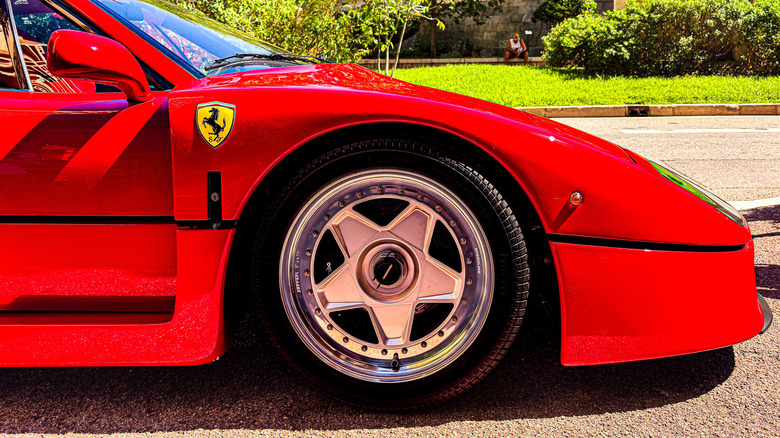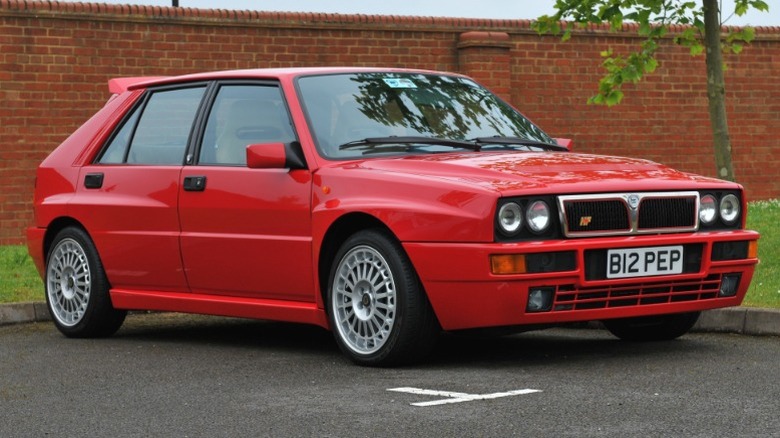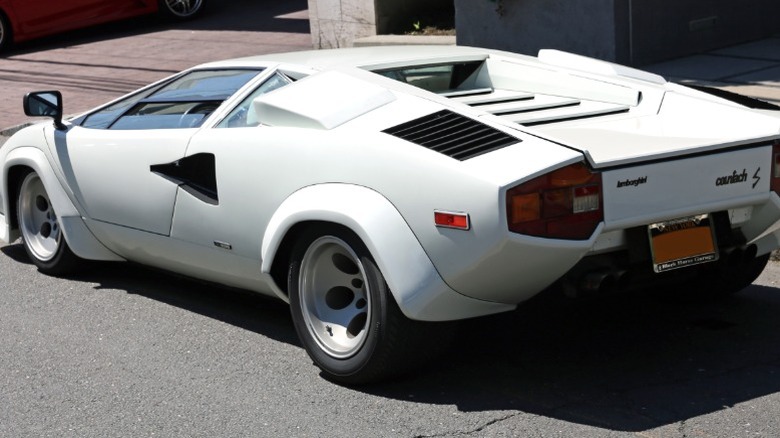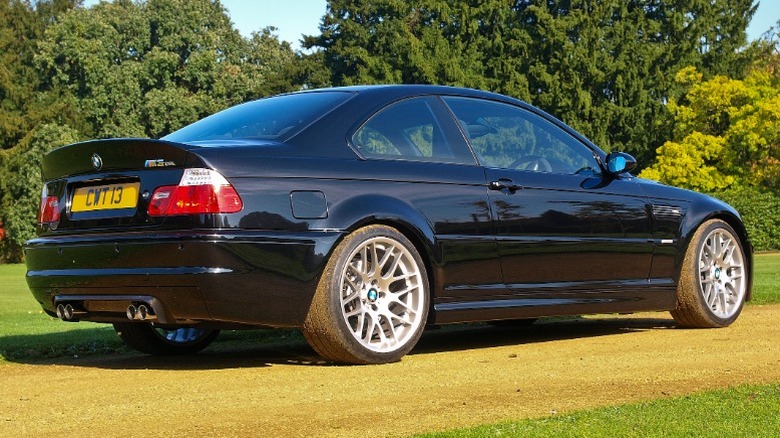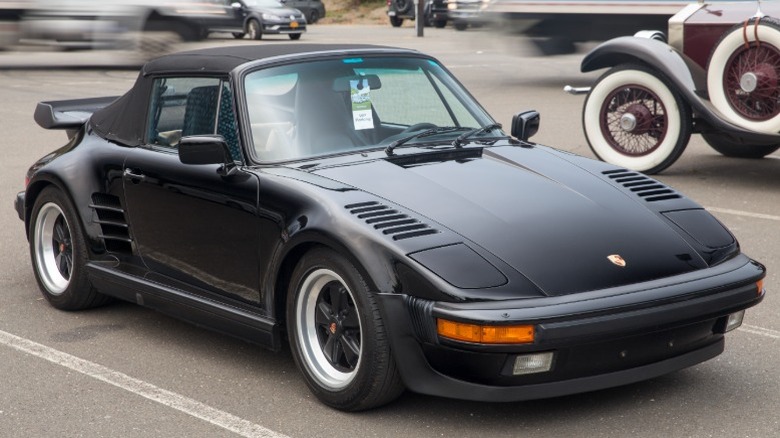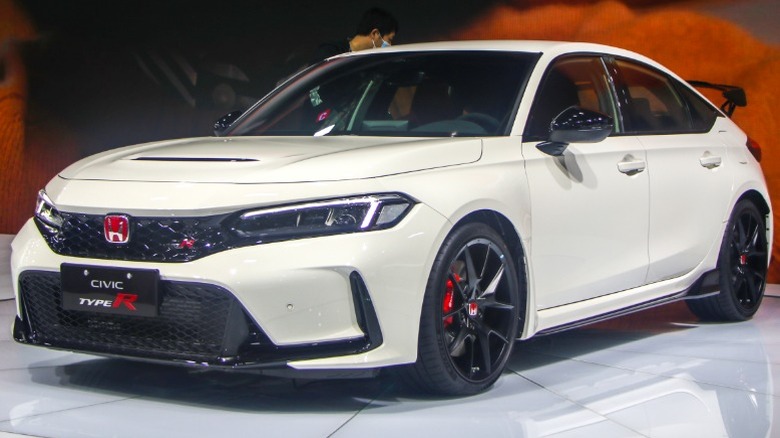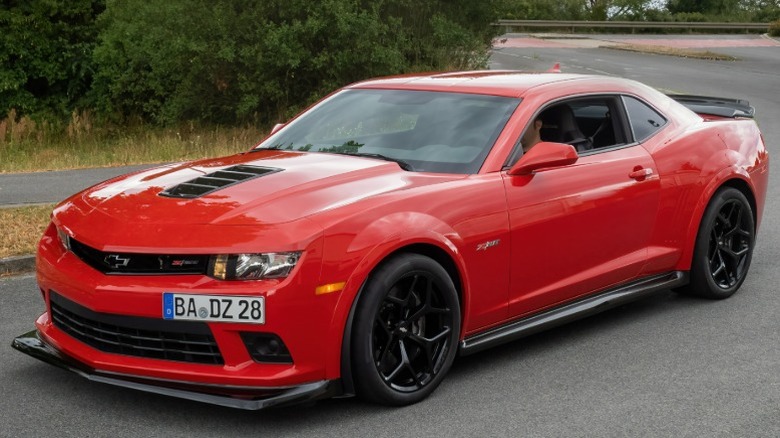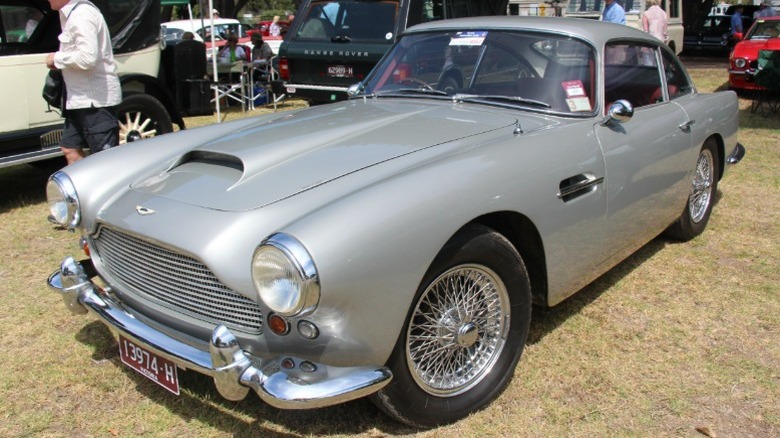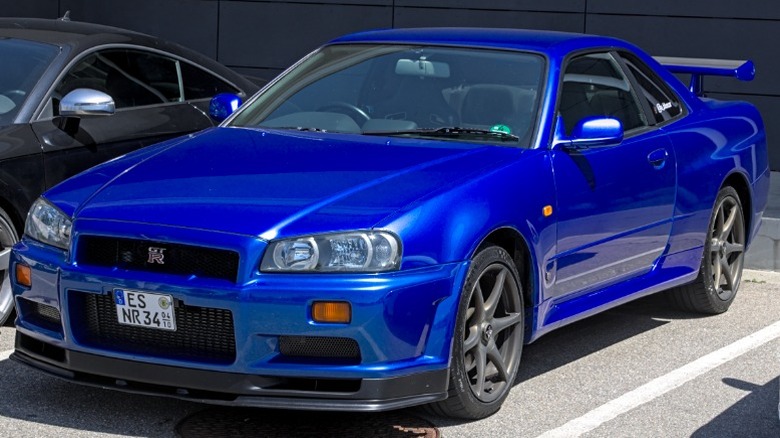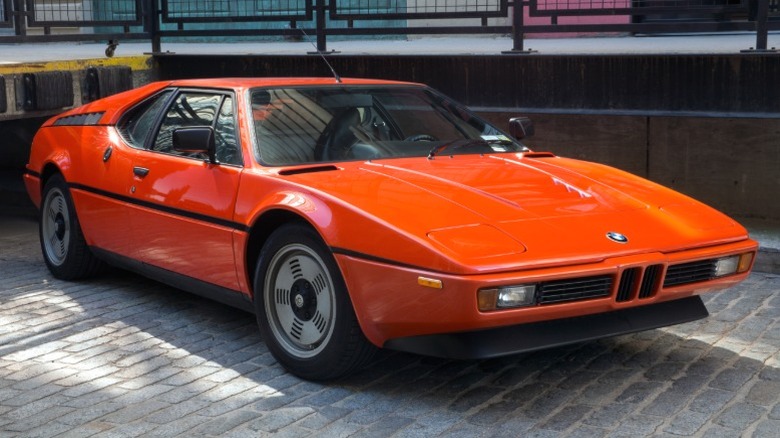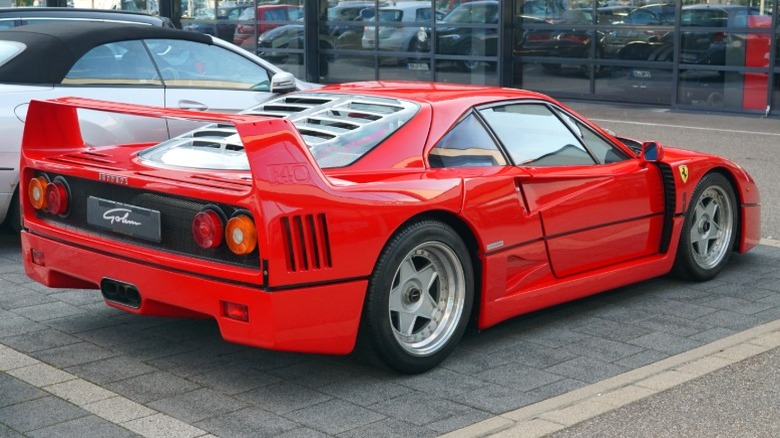10 Of The Best-Looking Wheels Of All Time
While they may not be the first aspect of a car that comes to mind, wheels are a huge part of a car's overall package. Wheels can impact a car's fuel economy, with larger and heavier wheels potentially costing you more at the pump when it comes time to fill up. They can also influence costs and ride quality, especially with 18-inch or larger wheels paired with low-profile tires, which are thinner and stiffer than standard rubber.
Wheels are also the icing on the cake for a car's looks, potentially elevating otherwise good-looking cars into great-looking ones. Think about it: Would the BMW E46 M3 CSL be quite as legendary without those multi-spoke BBS wheels? Can you imagine a 1980s Porsche 911 Turbo without its classic Fuchs wheels? Sure, both cars would still be awesome, but would they look quite as brilliant? Probably not.
So while it's quite easy to change wheels after the fact, there's something special about a car that ships from the factory with a great-looking set of wheels that perfectly complement the rest of the car. So that's why our list will focus solely on stock wheels. Sadly, that means you won't see iconic aftermarket wheels such as Rays TE37s or the "Initial D"-approved RS Watanabe wheels, as painful as it was to leave them out.
Lancia Delta Integrale Evoluzione
Let's kick off this list with the rally legend that is the Lancia Delta Integrale. And while most Delta Integrales had some pretty cool factory wheels — the eight-hole 15-inch units on the Integrale 8V, for instance — the Integrale we're talking about is the Integrale Evoluzione. This version of the Integrale debuted in late 1991 and came with a raft of upgrades, including a bump in power to 207 bhp and several tweaks to the suspension and underpinnings.
Those suspension tweaks are key for the subject at hand. Lancia changed the geometry, introducing wider front and rear tracks and raised strut towers. These changes meant Lancia couldn't stick with the old 15-inch wheels, as great as they were. Instead, the Italian automaker spec'd new 16-inch Speedline wheels for the Integrale Evo. The rest, as they say, is history.
Speedline's wheels were a work of automotive art, with 18 spokes and a smaller inner circle crossing those spokes. They're admittedly a bit busy looking, and far removed from the minimalist style of some modern wheels, but we think they look brilliant, especially paired with the Integrale Evo's chunky wheel arches and retro, angular styling. It's a match made in automotive heaven that'll send rally fans of a certain vintage into reveries, and it shouldn't be much of a surprise that you can buy replica versions to this day — or that Ford is echoing their vibe with its new retro appearance pack for the current Mustang.
Lamborghini Countach LP 400S
We go from one Italian marque to another, touching down in Bologna to take a look at the Lamborghini Countach LP 400S, bearer of what we think are some of the most iconic, instantly recognizable wheels of all time. Like the Delta Integrale Evoluzione, though, the Countach didn't come with these particular wheels from the get-go. The original LP 400 from 1974 initially matched its classy, minimalist exterior with similarly restrained multi-spoke wheels. They were great, but what came after would outshine them in every way.
Lamborghini unleashed the Countach LP 400S in 1978, bringing several now-signature design elements to the basic Countach shape. These included angular fender flares, ducting, and that unmistakable huge rear spoiler. But it also received fresh new wheels to match Pirelli's then-new low-profile tires, and these wheels were a stroke of genius. Instead of sticking to the original Countach's design, Lamborghini went with chunky magnesium wheels from fellow Italian company Campagnolo. These sported five circular cut-outs around the center hub, earning them the nickname of phone-dial wheels.
These wheels were nigh-on perfect — a classy minimalist design, combined with a slightly ridiculous radius on the rear wheels to accommodate the LP 400S' 345-millimeter rear tires. In a way, they encapsulated the Countach LP 400S as a whole: The basic shape was as striking as ever, but it was much more of a loud-mouthed braggart than the original Countach. And that's precisely why it's regularly hailed as one of the best Lamborghinis of all time.
BMW M3 E46 CSL
Let's jump forward in time a bit and turn our attention to a slightly more modern classic set of wheels, namely those on the BMW E46 M3 CSL, a limited-to-1,383 version of the fourth-gen BMW 3-Series. The M3 CSL — which stands for Coupe Sport Leichtbau, or "lightweight" — was, as the name suggests, a lighter and racier version of the M3 that many journalists and observers still hold in high regard, decades on from its 2003 debut.
The CSL wasn't that much more powerful than the M3, only sporting an extra 17 hp and 3.7 lb-ft of torque, but a selection of carbon fiber body panels and a stripped-out interior meant that the CSL weighed around 242 pounds less than the M3. Unfortunately, the CSL was also hobbled by a single-clutch automatic gearbox that wasn't particularly great, so it wasn't quite the performance slam-dunk it could have been. That said, one area where the CSL excelled was its looks.
The E46 M3 was already an excellent-looking car, but the CSL took it to the next level with its wheels. Its 19-inch multi-spoke wheels looked the part then and still look the part now, adding extra flair to the E46's otherwise clean and angular lines. BMW knew it was on to a winner with those wheels and eventually made them available for all M3 buyers in 2005 with the Competition Pack.
Porsche 911 Turbo (Type 930)
Porsche's 911 has been around for what seems like forever. First debuting in 1963, the 911 has gone through decades of refinement, culminating in the razor-sharp 2025 Porsche 911 Carrera S we drove earlier in the year. And while modern 911s are a feast for the eyes, the 911 that lives long in the mind is one from decades earlier.
Enter, the 1974 Porsche 911 Turbo, also known as the 930. Coming just a decade after the model's debut, the 911 Turbo was Porsche's first production turbo car. While turbocharged 911s are old hat now, Porsche's first attempt was raw and dangerous enough to earn the unfortunate nickname of the Widowmaker, partly thanks to its copious amounts of lift-off oversteer. We would never claim that dangerous cars are better, but there's a certain thrill in admiring a car with such a troubled reputation.
There's also much to admire the 911 Turbo for on purely aesthetic levels, too. There's its rear spoiler, in both whale tail and tea tray styles (the former on pre-intercooler models). There's the wider rear end, which makes the car look a lot more aggressive. And what really completes the package is the Fuchs wheels; these retained the five-spoke styling that debuted on the 1965 911 Carrera S, but were much deeper and more aggressive. The deep lip turned what would have been a slightly old-fashioned design into one that still looks great today, though we'd argue only a 930 can pull it off.
Honda Civic Type R
Honda perhaps isn't the most obvious name to see in a list full of illustrious marques such as Porsche, Lamborghini, and Lancia, but the Japanese automaker's recent iterations of the Civic Type R have sported some pretty eye-catching wheels. They're admittedly far removed from the retro cool of offerings like the Porsche 930's Fuchs wheels or the Lancia Delta Integrale's Speedlines, but they're pleasing to look at all the same.
The Civic Type R has come a long way from the late-'90s EK9, especially after Honda introduced a turbocharged engine to the Civic Type R in the mid-2010s. That shift to forced induction also brought with it a new look, featuring a much more aggressive and angular body befitting the significant bump in power. Honda toned it down slightly with the most recent version of the Civic Type R, which we found to be one of its few negatives when we tested it in 2023, but one area where the company has kept the new Civic's edgy aesthetic is the wheels.
Modern-day Type R buyers get a sharp set of multi-spoke wheels, with five main spokes splitting in two, for a total of 10 overall. It's not the most complex design ever, but we think the 19-inch wheels have a racey and edgy look to them that wouldn't look out of place on a car that's twice the price.
Chevrolet Camaro Z/28
Sticking to the modern theme for a while, we turn to the (dearly missed) mid-2010s Chevrolet Camaro — more specifically, the short-lived resurrection of the nameplate's famed Z/28 designation. Chevrolet's reintroduction of the Camaro Z/28 for the 2014 model year marked the first time it had featured on a Camaro since 2002, and the company duly ensured that the 2010s Z/28 was a special car indeed.
The 2014 Camaro Z/28 featured a hand-built LS7 engine under the hood, good for 505 hp and 481 lb-ft of torque. It's one of the most powerful engines ever put in the Camaro, but there was more to the Z/28 than raw power. Chevrolet targeted the Z/28 for trackday fanatics, spec'ing features like carbon ceramic Brembo brake rotors, Multimatic spool-valve dampers, and sticky P305/30/ZR19 Pirelli Trofeo R tires. It wasn't necessarily a setup that one would associate with a beefy muscle car, but it worked, the Camaro Z/28 earning praise for its handling and take-no-prisoners attitude.
Chevy also scored a home run with the wheels on which those Pirellis were installed. The blacked-out forged aluminum wheels are glorious, their thin and exaggeratedly angled spokes helping to both cut down on weight and give passersby a perfect view of the Z/28's premium brake setup. Are they elegant or classy? No, not at all. But they're a perfect match for the Z/28's naked, track-centric aggression.
Aston Martin DB4
Enough of modern 2010s wheels. We started this list off in full-on retro mode, and that's what we're going back to. Let's turn the clock way back to the middle of the 20th century and look at an offering from classic British automaker Aston Martin, the DB4.
The DB4 debuted at the London Motor Show in 1958 and was the latest in a line of DB models started by 1950's DB2. The DB4 was an impressive car, with the DB4 GT model from 1959 earning a place in the record books as the fastest car of the 1950s, its 302-hp inline-six engine taking the svelte coupe to a 160-mph top speed. Aston Martin also claims that the original DB4 was the first production car capable of doing the 0-100-0 mph run in under 30 seconds — nothing special now, but quite a feat for the late 1950s.
But Aston Martin's latest creation wasn't just about performance: It was also a beautiful coupe with incredibly sleek and tasteful lines, set off brilliantly by a set of wire wheels at all four corners. They are a bit busy and wouldn't work on most modern cars, but they're perfect on a classic British product. Not that the DB4 was the only Aston with wire wheels, though: the automaker had been using wire wheels since the DB2 and would continue to use them until the DB6, but the DB4 just works for us the best.
Nissan Skyline GT-R (R34)
Whether it's the relatively staid reproduction in the "Gran Turismo" games or the lurid, heavily-modified version driven by Brian O'Conner (Paul Walker) in "2 Fast 2 Furious," the R34 Nissan Skyline GT-R is a bona fide modern classic and undeniable pop culture icon.
Many hold the R34 Skyline up as one of the best Nissan sports cars ever made, and it's easy to see why. It was the pinnacle of the company's road-going engineering efforts and the last to bear the "Skyline" name, pairing the 2.6-liter RB26DETT engine with a host of fancy tech, including four-wheel steering, all-wheel drive, and active limited-slip differential on the V-Spec version. Despite only having 276 hp on paper, the R34's total package was such that it earned a reputation for being a supercar killer in its heyday — a reputation that its successor, the R35, duly continued when it debuted in 2007.
Although you're likely to see R34s sporting aftermarket wheels (Rays TE37s seem a perennial favorite), we think it's worth celebrating the R34's original six-spoke wheels. They're not very imposing, admittedly, but we think the thin spokes and subtle curves are really pleasing on the eye. They work really well with the R34's lines, too, to the point where we'd find it difficult to choose between the OEM wheels and a set of TE37s were we lucky enough to own an R34.
BMW M1
BMW is the only manufacturer featuring twice on this list, and it's simply because we really couldn't choose between the M3 CSL's multi-spoke wheels and those on the company's ill-fated mid-engined supercar, the M1. One of the best cars designed by famed Italian designer Giorgio Giugiaro, the M1 was a technical marvel initially designed for Group 4 racing. Unfortunately, delays in the production of homologation units stymied BMW's attempts to go racing with the M1.
BMW eventually built 460 M1s — including around 50 race cars — but that came too late: Group 4 was cancelled a few months after, and though M1s would later appear in competitions such as Group 5 and IMSA GTO, it's hard to not feel like the M1 didn't quite live up to its potential.
However, there's no denying that Giugiaro aced the aesthetic side of the equation. Not only was the M1 a peak example of his folded-paper design, but his Italian connections likely facilitated the use of a set of futuristic wheels from Campagnolo, the company behind the Countach LP400S' phone-dial wheels. And what a set of wheels they were.
The M1's wheels were almost entirely flat and opted for a radical inversion of the usual spoke arrangement. Instead of the aluminum or alloy material making up the spokes, Campagnolo opted to cut slats out of the flat surface to create a similar effect, and bring the added benefit of providing airflow to the brakes. It's a highly distinctive look that ranks among the all-time greats.
Ferrari F40
This list has been incredibly subjective, and we're sure some of you will have groaned in despair at one of our inclusions (or omissions). Despite that, we're pretty confident that this last pick will earn near-unanimous agreement — these wheels are indeed just that good. We're talking about the Ferrari F40 and its legendary Speedline wheels.
To be clear, the F40 isn't the only classic Ferrari to sport this general five-spoke design. The 308 GTB/GTS had a variation, as did the unobtainium 288 GTO, but the F40 had depth. Literally. The F40's wheels weren't a million miles away from those on the 288 GTO, with the highly visible and eye-catching nuts and bolts holding the wheels together. But its much thicker tires (265 and 335-millimeters front and rear, respectively) compared to the 288 GTO (which had 225s at the front and 265s in the rear) meant that its wheels were noticeably deeper, especially at the rear. And if you've read this far, you'll know that we like deep rims here at SlashGear.
Sure, the F40 would still be one of the best Ferraris ever designed without them, but its Speedlines are truly a perfect example of how wheels can elevate a car to true greatness. They suit the F40's race-inspired, Pininfarina-penned styling brilliantly and look stunning sitting under the F40's iconic rear wing. It's a combo guaranteed to set any observer's heart aflutter; these are the wheels that dreams are made of.
